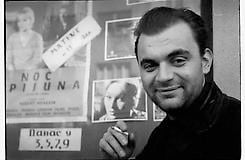
Tomislav Gotovac: Alexander Gray Associates
Image: Posing, 1964
Alexander Gray Associates announces the U.S. representation of the Estate of Tomislav Gotovac.
Tomislav Gotovac (b.1937, Sombor, Kingdom of Yugoslavia, now Serbia – d. 2010, Zagreb, Croatia), was a multi-disciplinary artist, considered the precursor of performance art in the former Yugoslavia, and a pivotal figure in the development of the artistic avant-garde in Eastern European during the 1960s and 1970s. He attended the University of Zagreb and the Academy of Performing Arts in Belgrade. He was strongly influenced by assiduously watching films throughout his life. A cinematic imagery intimately connected Gotovac’s personal life and artistic work, as he saw himself as both an actor in and observer of a constant movie. Gotovac carried out his first performance in 1954, developing a pioneering practice in conceptualism and performance, and becoming a mentor to a generation of Eastern European artists.
Tomislav Gotovac is most well-known for the use of his own body in his work. Approaching his body as a readymade, he began staging photographs of himself in the 1960s. During this decade he directed experimental films that made use of continuous repetition of images that revealed personal stories. Consciously situating his films in relation to the work of directors and musicians he admired—Billie Holiday, Glenn Miller, Jean Luc Godard, and Carl Dreyer, among others—he often alluded to them through formal quotations or by incorporating musical compositions into his own films. During this time, inspired by jazz compositions, he created collages applying cinematic editing principles to create montages using personal items such as cigarette cases.
In the 1970s, Gotovac heightened the exploration of his body as a medium in the public space. His physicality was both expressive and malleable, often changing his appearance before or during his performances. He engaged with the urban environment and passersby through symbolic acts often performed unclothed. As curator Jesa Denegri writes, “Literally baring himself, he should be able, intermediately, to bare all those who in their own everyday lives resist and are afraid of the risks of any kind of change. Exposing his own naked body in a public place is for Gotovac a direct gesture, and a symbolic deed of freedom of behavior.”
During the 1980s Gotovac further investigated self-expression through a series of performances that placed his body and physical transformation at its core, among them were Haircutting and Shaving in Public (1981), Lying Naked on the Asphalt, Kissing the Asphalt (better known as Zagreb I love you, 1981), and the action of vending the paper Polet (1984–85), among others. These performances are emblematic of Gotovac’s treatment of his body as both object and subject transforming himself into a readymade. Gotovac continued to provocatively utilize his body in films, performances, and photographs throughout his career; such as his performance Foxy Mister 2000 (2002) where he published photographs of himself posing as a sixty-five year old man imitating the poses of female porn models.
Tomislav Gotovac’s work has been exhibited extensively throughout Europe and the United States. In 2003, he was the subject of a retrospective at the Museum of Contemporary Art, Zagreb, Croatia. His work has also recently been featured in such institutions as the New Museum, New York (2014); Museum of Contemporary Art, Ljubljana, Slovenia (2014); Kunsthalle Wien Karlsplatz, Wien, Austria (2013); Museo Nacional Centro de Arte Reina Sofía, Madrid, Spain (2013); Ludvig Múzeum, Budapest, Hungary (2012); Musée d’art contemporain du Val-de-Marne, Vitry-sur-Seine, France (2012); Van Abbemuseum, Eindhoven, the Netherlands (2011); and Muzeum Sztuki Nowoczesnej Warszawie, Warsaw, Poland (2011). In 2011, he represented Croatia in the 54th Venice Biennale. His works are in notable public collections including the Museum of Modern Art, New York; Centre Georges Pompidou, Paris; Museum of Contemporary Art, Belgrade, Serbia; Museum of Modern Art, Ljubljana, Slovenia; Museum of Contemporary Art, Zagreb; and the Museum of Modern and Contemporary Art, Rijeka, Croatia.